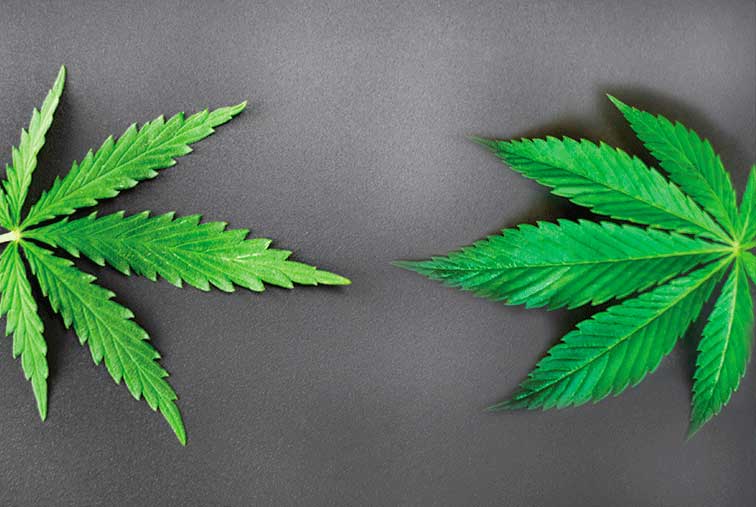Sativa Vs. Indica | The Difference Between Marijuana Strains

Medically Reviewed By: Manish Mishra, MBBS
Sativa and Indica were historically two separate species of cannabis with distinctive properties. However, virtually all recreational and medical cannabis in the United States takes the form of designer hybrids with a wide variety of unique characteristics.

How many species or types of cannabis are there? What are their chemical and practical differences and how does this impact their recreational or medical use, and their addictive potential?
These are important questions, as there have historically been significant and well-understood differences between sativa and indica cannabis strains and their medical or recreational uses.
In modern use, however, all popular cannabis plants or blends are hybrids, cultivated to have any number of diverse properties.
Cannabis Strains
According to some, there are three types of cannabis in general circulation:
Indica Strains
Indica plants have thick stems and broad, dark green leaves. They are known for causing a body high with sedating feelings of relaxation and drowsiness, as well as potential couch lock. They originate from Afghanistan, India, and Pakistan.
Sativa Strains
Sativa plants are taller and have narrow bright green leaves. They are known for a head high characterized as energizing, uplifting, creative, buzzy, and prone to mild hallucinations or paranoia. They originate from Thailand and South America.
Hybrid Strains
These strains, which cross and combine both other species in unique proportions, may have a wide range of different effects depending on the specific expression and concentration of specific chemical compounds.
The Modern Myth Of Indica & Sativa
Recent studies have shown that virtually all cannabis products used in Ohio and the United States today are cultivated hybrids, even if they are presented as being pure indica or sativa cannabis.
Moreover, by tweaking the amounts of THC and CBD, as well as the terpene content of different strains, growers have been able to create any number of designer blends with effects that may be sharply in contrast with their physical appearance.
In fact, rather than referring to specific strains, the terms sativa and indica are increasingly giving way to more accurate descriptors like sativa-dominant, indica-dominant, or more informational descriptions of the plant’s chemical makeup and terpene content.
Even the term “hybrid” in current usage has come to refer more to marijuana strains that blend the properties and effects of indica and sativa-dominant strains.
Indica Vs. Sativa: Origins
In 1753 the Swiss naturalist Carl Linnaeus classified all cannabis plants as a single species: Cannabis sativa.
But in 1785 the French biologist Jean-Baptiste Lamarck divided cannabis into two species, Cannabis sativa and Cannabis indica, citing physical differences between the plants as well as their differing origins and growing patterns.
The indica plants, due to their lower stature and broader leaves, were able to grow in colder climates, absorbing more sunlight and heat and expending less energy with a shorter flowering period.
Sativa, in contrast, grew in warmer climates with a long growing and flowering season.
In these early days, each of these natural species also had a distinctive chemical makeup, including distinctive concentrations of cannabinoids (primarily THC and CBD) and terpene profiles (chemicals responsible for giving plants their distinctive aromas, flavors, and coloration).
Cannabis Facts
With literally hundreds of popular hybrids in circulation, the distinctions in effects, uses, and risks between different strains of recreational or medical marijuana can be important to understand.
Strains With High THC Content
THC, or delta-9-tetrahydrocannabinol, is the chief psychoactive component of cannabis and is currently illegal at the federal level and in many states.
Strains with high levels of THC are primarily used for recreational purposes, though THC can also be used to treat nausea, pain, anxiety, muscle spasms, and other conditions. THC-heavy cannabis strains are also thought to be more promoting of addiction if used chronically.
Strains With High CBD Content
CBD, or cannabidiol, is legal under federal law.
While not an FDA-approved medication for the treatment of chronic pain or other medical conditions (with the exception of Epidiolex, an epilepsy medication), CBD is widely used non-medically for anxiety, insomnia, inflammation, and epileptic seizures.
In fact, some strains of cannabis have been developed with such low amounts of THC and such high concentrations of CBD that they are not considered a controlled substance.
Terpenes
Terpenes like limonene, caryophyllene, and myrcene, aren’t psychoactive on their own, though they may impact the effects of cannabis by interacting with THC, CBD, and other cannabinoids through what is known as the entourage effect.
As such, cannabis users are playing increasing attention to terpene profiles and the effect they can have on a strain’s properties as a whole.
Other Factors
The effects of any cannabis product will also be strongly influenced by a person’s personality, internal body chemistry or tolerance, how it is taken, dosage, and the set and setting in which it is used.
While not everyone who uses cannabis develops a cannabis use disorder, a significant minority do. If you or a loved one struggle with marijuana abuse, contact Ohio Recovery Center to learn how we can help.
- Cannabis Cannabinoid Research https://www.ncbi.nlm.nih.gov/pmc/articles/PMC5576603/
- National Institute on Drug Abuse (NIDA) https://nida.nih.gov/publications/drugfacts/cannabis-marijuana

